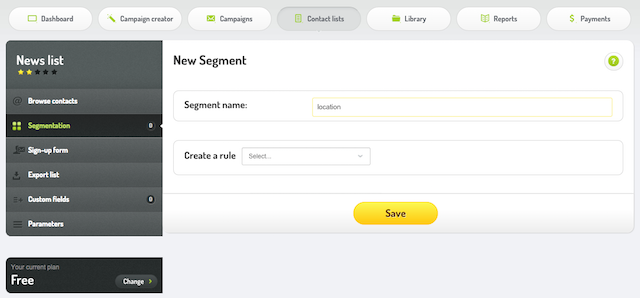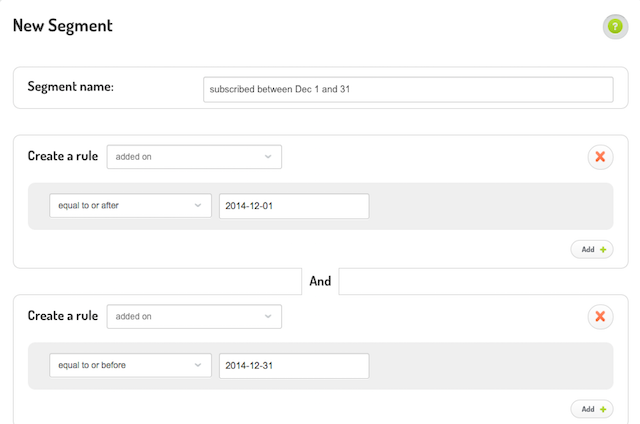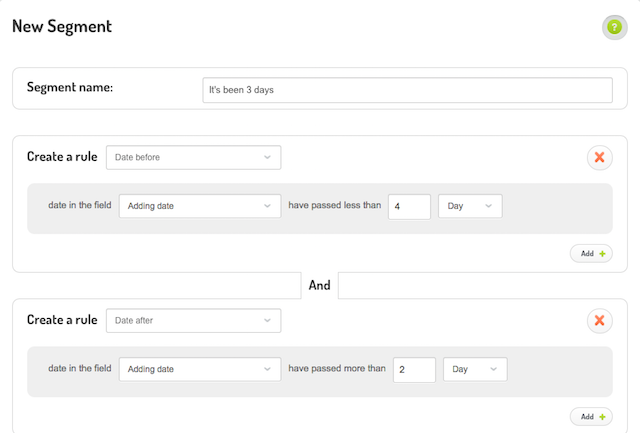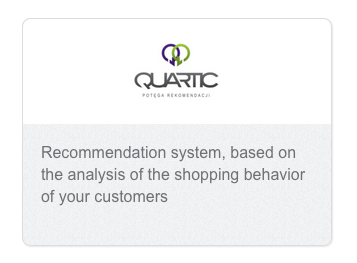Manage your subscriber database – segmentation
Back to list of guides
1
Chapter
Why should you divide subscribers into segments?
Chapter
Email marketing is an incredibly effective marketing tool. A marketing email can be sent to everyone, but it reaches every individual with a personalized message.
If you put enough work into the process and prepare the database, you may reach a very satisfying level of sales, as, on average, one Euro invested in this channel of communication may generate as much as 40 Euro in return [according to research performed by Direct Marketing Association].
So there’s your answer to the question “Why should I do this?”.
Let’s take a look at an example to illustrate what email can do
Imagine that you are handed a flyer as you walk into a large shopping center - you might be interested but the overwhelming probability is that you, and almost everyone else who gets the flyer, will not be interested. You would react much better to an offer that you get when walking into a specific store since you are obviously interested in what it has to offer (otherwise you wouldn’t be walking into it, would you?). The response rate for such an offer would be much higher since it’s targeted at people who are interested in what’s on offer rather to people who happen to be in the same building as the store. If that flyer includes some kind of discount code, then the interest would be even greater.
You should think in a similar way when designing a communication strategy for email marketing campaigns and recognize the importance of what you send and to whom.
Segmentation in email marketing
Dividing your subscriber database into segments is a particularly important process for several reasons.
- First of all, dividing one list into smaller lists allows those lists to be managed more efficiently.
- Secondly, it allows subscribers with similar interests or characteristics to be gathered together.
- It makes it possible to select subscribers who perform similar actions after reading a message.
If you don’t have a good idea for an emailing campaign take a look at previous campaign statistics. Try to find a common denominator in subscriber behavior and build your new offer based on what you learn. All of the options listed in this guide are available in the “Segmentation” tab of the FreshMail system.

Also, use the possibilities available by FreshMail like the possibility to create an unlimited number of segments. The more records in your database, the more differentiated it is, and while you create segments as the database grows you also keep it in order, which in turns makes your future campaigns using segmentation that much better.
2
Chapter
Segmentation for beginners
Chapter
How to combine segmentation rules?
If you are interested in dividing your database into more precise segments, you can combine different segmentation rules. This can be done in a few different ways.
Different conditions for the same rule
The “or” conjunction can prove useful if you would like to group subscribers who independently fulfill different conditions within one rule in a single segment. For example, your lists include information about which email services your subscribers use. Let’s say you intend to send emails only to those subscribers who use one of two email services. There are no subscribers who meet both of these conditions at the same time - you only have addresses for a given subscriber in one email service provider or the other. Therefore you can create a segment using a double rule and the “or” conjunction.

Using different rules simultaneously
The “and” conjunction allows you to group subscribers who meet the conditions of several rules simultaneously. Let’s say that you would like to select a group of people who subscribed to your newsletter during a specific period, say during the month of December, 2014. Creating a segment including these subscribers requires you to use a double rule. The subscription date must be later or equal to December 1 and, at the same time, it has to be earlier than or equal to December 31. The conditions of this segment should be defined as follows:

Attention! It is important that the dates are defined in the YYYY-MM-DD formatFormat HTML + TXTWiadomość, która zawiera format HTML i TXT. Programy pocztowe, które nie będą mogły odtworzyć wiadomości w formacie HTML, wyświetlą ją w formacie TXT. Należy pamiętać, że wyświetlenie wiadomości w formacie TXT uniemożliwi zraportowanie jej w kontekście otwarć. (this also applies to dates entered in custom fields in subscriber lists).
Defining a specific period that has passed since the day of subscription is another way to do this, e.g. 3 days ago. In this case use the “Date earlier than” and “Date later than” rule, using the following configuration.

The newly created segment will be updated on a daily basis, which means that it will always include addresses of subscribers who joined 3 days ago.
Can you create an additional subgroup within the segment? Sure you can!
You can create sub-segments within your existing segments in your subscriber database. All you have to do is click on the “plus” icon next to the name of the given segment and choose a rule that will define further conditions to be fulfilled by subscribers.
3
Chapter
How to divide email campaigns into segments based on transaction data
Chapter
From FreshMail’s point of view, transaction details are a kind of declarative information, which are made available to marketers and can be used when creating a message template.
What is transaction data?
Transaction data includes all the information that the mailing system gathers through the API of a given e-commerce platform. When properly connected, both systems can integrate to such an extent that as a result they can provide you with information like: user name@company.com bought a green blouse last time they visited your site.
If you have segmented date gathered from an online shop, you can precisely personalize messages to you customers.
Example?
Let’s say someone bought a handbag and a pair of shoes of the same color in your shop last month. If you would like to motivate her to make additional purchases and reward her for shopping in your store you can send her a message with a discount code for stylish belts that match the color of the items she purchased previously.
4
Chapter
Email campaign segmentation based on declarative data
Chapter
Segmentation based on declarative data is the simplest way to divide subscribers into smaller groups. It is made on the basis of information that the subscriber was willing to provide during the newsletter subscription process. The subscription form often includes one or more additional fields where you can ask for the subscriber’s name, address, post code, birth date and other useful information.
Do not try to get too many details
When you create your subscription form you have to remember that at this level of "acquaintance” people are not willing to share too much information about themselves. When designing additional form fields, be sure that the information you are about to ask for is really necessary.
Asking for too many details may significantly lower the conversion rate of your form - people will subscribe less often in part because you want to obtain too many private details about them. Always stick to the funnel rule, first ask for the most important information, then for less crucial details, etc.
What data should be collected?
When deciding what data to collect you should always ask yourself if this information is absolutely necessary to create an effective offer.
Subscription forms most often ask for:
- email - yes. This is the only bit of indispensable information that you must have.
- name - yes. Thanks to this field you can differentiate between men and women. It will allow you to personalize certain elements of the message (subject, content) that may increase conversion (which means more subscribers will open your emails) by up to 50%. It also allows for different messages to be sent out to men and women. Moreover, if your email is commercial in nature, you can work with particular colors and images based on gender - this often works well.
- city - not necessarily. There is no need to ask for the city if you don’t have any physical shops in the real world and your business is completely focused on e-commerce. Also, remember that you can retrieve information as to where your email was opened from FreshMail reports after sending your campaign out.
- age - again, not necessarily. Think about what advantage this information gives you. Do you need to know how old your subscriber is if you sell kitchen equipment?
- fields of interest - no. Recognize that signing up for a newsletter is a declaration of interest in the category of products that it offers.
What’s the use of all this?
Declarative data can be used to divide databases into logical segments. You can create rules regarding values provided in a particular field of the form. For example, you can use the following elements to create rules:
- equals field e.g.: city equals London - if you would like to target subscribers from that city
- include field e.g.: industry includes “constr” - if you would like to select people working in industries that include this string of characters e.g.: construction, or constructor
- field does not include e.g.: industry does not include “constr” - if you would like to exclude anyone working in this particular industry
5
Chapter
Email campaign segmentation based on behavioral data
Chapter
This is about targeting users based on actions that you know they performed in response to emails you have already sent them. This kind of segmentation is critical to your success since it is based on previous behavior that helps you to know where different subscribers are in the conversion process.
What can you do with an email?
The rules that you can use to create segments of your database relate mostly to subscriber interactions with your newsletter. This refers to the following functions allowing grouping (segmentation) on the basis of the following rules:
- the subscriber opened an email
- the subscriber did not open an email
- they opened an email and clicked on any link or a particular link
- they opened an email and didn’t click any link
- the subscriber did not receive a given message
Based on these rules you can create very effective segments, especially if your offer includes the possibility to send some additional information or remind your customers of some event. Combined with information about the name of the subscriber, the location where they opened their email and the time and the date when the email was opened you can create an email campaign that would impress even the most experienced marketer.
How to create business out of data?
Let’s illustrate it by using an example.
Let’s say you are organizing a conference and you send a general email to everyone, including information regarding the date and location of the conference and a link to where you can register.
After 2 or 3 days you analyze reports and subscriber behaviors. You can divide them into the following groups and then personalize each following email in order to achieve better results:
- those who didn’t open the email - you can send another email, change the sender’s name or the subject of the message
- those who opened the email, but did not click on any links in the message - you can send another email informing them about the limited availability of places and the fact that there is a risk of missing out if they don’t act now
- those who opened and clicked the link but did not buy a ticket - you can send a message including a personalized discount to encourage them to register as soon as possible
- those who opened the email and booked a place at the conference - you can send an email with premium content about events related to the conference
If you divide your database into segments properly and create a universal email that requires little work regardless of the segment it is about to be sent to, your email marketing activities will become very effective.
But remember...
The most important thing is to never actually mention in the message anything that might suggest that you have data that indicates what users did or didn’t click on. Including something like “We know that you are interested in time management training because you clicked….” is a mistake because most people don’t like (and perhaps don’t even realize) that you know exactly what, where and when they clicked.
Naturally, it is a completely different situation if someone is actually present during a training session and you send them a message saying “We’re happy that you took part in our time management training. Below you will find some additional information that you may find interesting and which will help you manage your time better.”
Naturally the above is just an example - depending on the industry, data can be used in many different ways.
6
Chapter
How to use tags for links and campaigns
Chapter
FreshMail includes a very helpful function that gives you the possibility to tagTagZnacznik stosowany do klasyfikowania fragmentów tekstu. Pozwala na grupowanie odnośników (linków), umożliwia tworzenie grup na podstawie m.in. kliknięć linków oznaczonych za pomocą tagów. links with certain words that will be used in a given campaign, and even tag an entire campaign. This option is quite useful since it makes it possible to save quite a lot of time.
An example with TV sets
Let’s say you manage an online store with electronic equipment. In your emails you usually send an overview of your current offer so the email will include an XYZ 32-inch TV, a ZYX 40-inch TV, a tablet, a home cinema system and 10 other items at a great price.
Now, let’s assume you send those emails once a week. After a year you’ve done 50 campaigns and you’d like to create a segment of clients interested in TVs. Using typical behavioral targeting you would have to create a group of over 50 “persons who opened the email and clicked the link" rules. Moreover, another rule would have to be added to each new campaign.
It’s always a good idea to save time whenever you can. Tagging is one of those functions that helps you save time and increase the effectiveness of your emailing campaigns.

Let’s say that you will mark all links to TV sets with a “TV” tag. Now all you have to do is create a group of people who:
opened a campaign and clicked a link marked with the “TV” tag.
One rule will collect complete data from all the campaigns and more, it will automatically include new subscribers from future campaigns.
Of course, each link can be marked with several tags depending on what kind of data you need. You can create similar actions by marking an entire campaign with tags. Those kinds of segments work very well for e-commerce.
An example with candies
You have a sales catalogue template. It includes lemon, strawberry and caramel candy. Your offer includes 3 products in each category.
Right before sending out the campaign you can group product links using tags. The most simple way to do this is to use the tag “citrus” for lemon, “fruit” for strawberry and “sweet” for caramel.
If products within a single category differ, for example, they are of sold in packs of different sizes, you can tag each link separately - “citrus 100g”, “citrus 2kg”, “citrus 10kg”.
Now, here’s the most important piece of information. Id doesn’t matter how many newsletters you send out, by tagging proper links and creating groups of people who click tagged links you will be able to meet their needs and interests more precisely.
You will get a similar effect by tagging campaigns - “candy”, “accessories” - when you send product for storing candy, or “wholesale” - when you send out deals above 10kg.
7
Chapter
What is loyalty based targeting?
Chapter
Another way to divide subscribers into segments is targeting based on the number of opened messages compared to the total number of sent messages, that is, based on subscriber loyalty.
Take a closer look at your subscriber database
When carrying out emailing campaigns you will notice that only a small percentage of subscribers in your database opens your emails. When analyzing reports, it may also turn out that there are people on your list who haven’t opened any of your emails for quite some time. In that case, with a bit of historical data (at least 6 months if you send newsletters twice a month) you can create groups based on subscriber loyalty.
This means that we can create a group of subscribers who opened at least X% of emails since the first time they received one from you. Usually, it makes sense to create three segments of subscribers.
The loyal group
The first segment includes those subscribers who opened at least 75% of the emails that were sent to them. This group can be called the Loyal Group and it requires a change of your emailing strategy.
You should definitely recognize and appreciate their engagement and reward them for their loyalty by, for example, by providing them with some premium content. In order for any actions targeted at this group to increase the engagement of remaining subscribers you could inform others that their loyalty will be rewarded. Usually the following campaign will have a higher Open RateOpen rate (OR)Procentowy wskaźnik, który pokazuje stosunek unikalnie wyświetlonych wiadomości do wiadomości wysłanych. - if you can get a reward just for opening an email then why not do it?
The “it depends” group
The loyalty of the second group varies between 25-74%. Members of this group may be converted into Loyal Subscribers with a bit of optimization.
In this case optimization should focus on A/B testing of the subject (and/or) sender of the message in order to activate readers. You can also check to see if the sending time of the messages (time of the day/day of the week) is optimal.
The disloyal group
The third group includes subscribers who open less than 24% of your emails. These will be very difficult to encourage to open your future emails.
You should consider an entire makeover of your approach to this group that not only includes optimization of the subject/sender/time, but also the content of your messages. Perhaps they aren’t providing enough value for your subscribers or maybe you should reduce the number of messages you send. It’s also worth trying to attract this group to your content using a discount mentioned in the subject line of the message.
Activation of this group is very difficult and there is no single recipe for it - everything depends on the industry that you operate in. Don’t get discouraged, just experiment and diversify your campaigns.
8
Chapter
Using geotargeting
Chapter
Another kind of targeting is the possibility to divide subscribers into segments based on their physical location. There are two kinds of segmentation that can be used here.
Geolocation in email marketing
Another method of geotargeting is detecting where the email was opened, where clicks were made and where someone subscribed. The method is not very accurate due to current technical limitations. Mobile internet IP addresses often refer to the headquarters of the company, not the location of the user and, when they are tied to a user’s location, are generally not as accurate as other methods of geolocation.
This function, despite statistical inconsistencies, is capable of presenting you with information on where your subscribers open your emails most often. This will allow you to personalize your campaigns based on their actual location.
Why do this?
To explain the advantages of these functions I will use another example. A travel agency sends the same newsletter with an overview of their offer to every one of their clients.
A subscriber from one part of the country opens their email, finds an interesting trip, then another one, and another one, each time they see that the city of the departure for the holiday is a six hour trip to the other side of the country. You can see how frustrating this would be and how that potential customer would quickly lose interest.
Using geolocation, you can prevent this from happening and send personalized offers to subscribers with holidays leaving from the city most convenient for them. Problem solved.
9
Chapter
How to use segmentation options effectively
Chapter
Divide into segments
With access to historical data and your database at your disposal there’s nothing else left to do other than analyzing and drawing conclusions from the data you obtain.
The knowledge that you gather will allow you to segment your database properly and then send personalized emails, which always bring better results than sending the same email to everyone.
Join different segments
See what kind of data FreshMail provides you with, then compare it with the data you get from your subscribers. The next step is deciding how you will put this to work in your email marketing communication strategy. All that’s left to do is divide your database into segments and send personalized emails.
It seems like a lot of work at the beginning but the results are worth the effort.
Remember...
Just as the same piece of advice doesn't apply to everyone, you shouldn't send the same message to all of your subscribers.
If you can't personalize your offer in any way, don't waste your time on segmentation!


